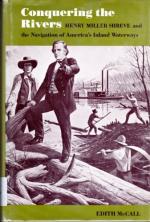|
This section contains 375 words (approx. 2 pages at 300 words per page) |
Encyclopedia of World Biography on Henry Miller Shreve
Henry Miller Shreve (1785-1851), American steamboat designer and builder, improved water transportation and navigation on the western rivers. He helped make possible the great era of steamboat traffic prior to the Civil War.
Henry Shreve was born on Oct. 21, 1785, in Burlington County, N.J. When he was 3 years old, the family moved to western Pennsylvania. He grew up on the Youghiogheny River, watching the steady movement of men and goods bound westward for the nation's interior. At about the age of 15 he began working on the keelboats, barges, and pirogues which plied the Monongahela and Ohio rivers. He spent the rest of his life on the western rivers.
Shreve owned and operated keelboats and barges in the years when Robert Fulton was developing the first steamboat. In 1813 Shreve himself entered the business of building and operating steamboats. One of his boats, the Enterprise, made the first complete upriver trip from New Orleans to Pittsburgh. In 1816 he designed and built a new kind of steamboat which became the prototype for the great Mississippi steamers. This boat, the Washington, had a shallow-keeled hull, a main deck housing engines, and an upper cabin deck topped by the pilot house. All the great steamboats of the ensuing era were built from the design conceived by Shreve.
Shreve successfully fought to break the monopoly on steam navigation enjoyed by Fulton and Robert R. Livingston. These two had obtained a 14-year monopoly from officials of the Orleans Territory, and they tried to prevent Shreve's vessels from operating in the lower Mississippi. In 1818 the courts dismissed a suit against Shreve for navigating restricted waters, thus opening the river to all potential entrepreneurs. Full development of the commercial opportunities in the interior followed.
In 1827 the Federal government appointed Shreve superintendent of western river improvements, a post within the War Department. He began a vigorous program of removing obstacles to the safe passage of river traffic. He designed new boats to dislodge and remove snags from the rivers, a constant source of danger to steamboats. By 1834 boats ran at night through many channels formerly unsafe even in daylight. Shreve's work made travel much safer on the western rivers. He retired in 1841 to a residence outside St. Louis and died there on March 6, 1851.
|
This section contains 375 words (approx. 2 pages at 300 words per page) |


